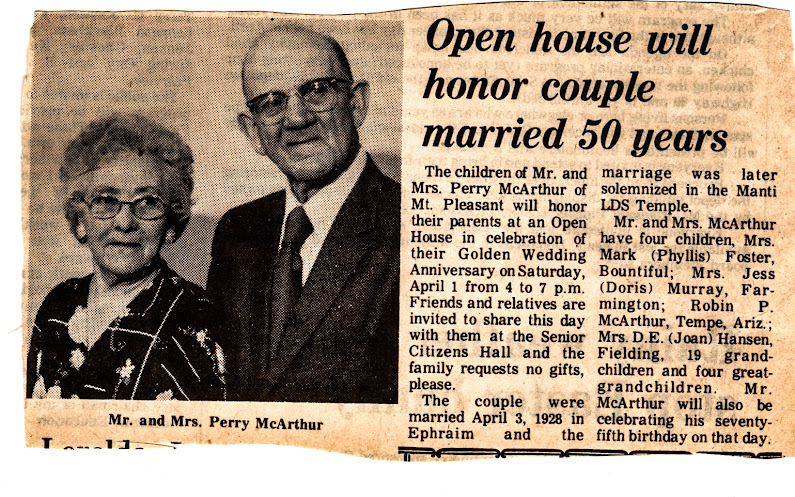Thomas Orthell Allred
June 3, 1937 — September 4, 2024
Spring City
Our family’s hero, Thomas O. Allred, passed away Wednesday, September 4, 2024, in Spring City, Utah, at the age of 87, on the same property where he was born on June 3, 1937. Born to Iris and Parley Orthell Allred, he was the third of four children.
Tom was born and raised in Spring City and attended his elementary education at the old stone schoolhouse. He graduated from North Sanpete High School in 1955. While he began working immediately following high school, he studied Mechanical Engineering at Snow College, University of Utah and the University of Nebraska. He was truly a lifelong learner.
Tom is survived by his wife, Dora (Madsen) Allred, and his three siblings Sherlene Larsen, Pat McGerty, and Richard (& Laurel) Allred; and his five children, Katherine (& Don) Vialpando, Nancy Allred; Sam (& Bob) Boland, Christian (& Emily) Allred, and Jason (& Kristy) Allred. Additionally, he’s loved and adored by his 18 grandchildren and six great grandchildren. His welcoming committee on the other side includes his parents; Dora’s parents Cleah & Theadore Madsen; his brother-in-law Frank; and sister-in-law Dorothy; his son-in-law Chuck, granddaughter-in-law Crystal; and his grandson Zachary; and many of his close friends recently departed.
Tom’s adult life began with the marriage to Dora Ellen Madsen. Their marriage marked the beginning of a long and happy life together. He and Dora were married November 9, 1956 in the Manti LDS Temple. In November, they would have been married 68 years.
Soon after their wedding, he began working at the wool mill, then became a 3rd Machinist Apprentice with the Union Pacific RailRoad. He would rise in the company by taking positions as District Foreman in Hermiston Oregon, Asst. Superintendent (Green River, WY), then District Superintendent (Cheyenne, WY), and was then moved to UPRR’s Headquarters in Omaha, NE where he worked in the Engineering Department. Lastly, he moved to Little Rock, AK, where he worked within the Quality & Safety Department.
He retired from Union Pacific at age 53 and moved back to Mt. Pleasant, where he and his sons built a beautiful home where he and Dora would live during retirement and use as a gathering place for his family. Gratefully, Nancy and her son, Dustin, joined them and have taken care of Tom, Dora and the home over these many years.
Tom was well traveled and enjoyed seeing new places. He travelled to faraway places such as Australia, New Zealand, Mexico, Peru, Chile, Argentina, South Africa and Nova Scotia where he enjoyed seeing the cultures and meeting the people of these countries.
Tom dedicated himself to serving others. He would participate in any opportunity to help others and taught his children to do the same. He served as City Councilman in Spring City for 12 years. He enjoyed working on his retirement hobby farm known as “Uncle Tom’s Farm” and was well known for the sweetest corn and melons in the area; and for a flourishing Pumpkin Patch, which was often painted by his favorite local artists and that received visits from the elementary school kids where each were given the chance to pick out a pumpkin to take home. For decades, he could be found plowing snow from the Spring City streets and church parking lots, and never forgetting the driveways of several widows.
But his most cherished acts of service were those that he dedicated to serving within the Church of Jesus Christ of Latter-Day Saints. He served in various roles, and enjoyed serving as Counselor to four bishops. He and Dora served a Full-time Service Mission in the Bishop Storehouse. He also served weekly as a Temple Worker in the Manti LDS Temple for 20 years where he loved the work associated with the gathering of Israel within the temple.
The legacy he leaves behind is one of dedication, quiet strength, love and incredible faith. He took pride in knowing he could work as hard or harder than anyone and would show his love through actions rather than words. His greatest love was that of his dear wife, children and extended family.
As we bid Tom farewell, his impact on the lives he touched is immeasurable. May we all come to know the strength of faith that he had and honor his memory by living with similar commitment to things we care about. Though he may no longer walk beside us, his spirit will forever watch over and inspire us.
Funeral services wereheld on Monday, September 9, 2024, at 12:00 p.m. MST. A family viewing was held starting at 11:00 a.m. prior to services at the Church of Jesus Christ of Latter-Day Saints at 15000 N. HWY 117, Spring City, Utah 84662. There will be a viewing on Sunday evening from 5:00pm to 6:30pm also at the church.




























